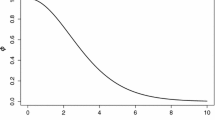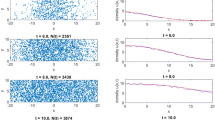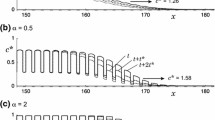Abstract
Animal movement behaviors vary spatially in response to environmental heterogeneity. An important problem in spatial ecology is to determine how large-scale population growth and dispersal patterns emerge within highly variable landscapes. We apply the method of homogenization to study the large-scale behavior of a reaction–diffusion–advection model of population growth and dispersal. Our model includes small-scale variation in the directed and random components of movement and growth rates, as well as large-scale drift. Using the homogenized model we derive simple approximate formulas for persistence conditions and asymptotic invasion speeds, which are interpreted in terms of residence index. The homogenization results show good agreement with numerical solutions for environments with a high degree of fragmentation, both with and without periodicity at the fast scale. The simplicity of the formulas, and their connection to residence index make them appealing for studying the large-scale effects of a variety of small-scale movement behaviors.








Similar content being viewed by others
References
Armsworth PR, Bode L (1999) The consequences of non-passive advection and directed motion for population dynamics. Proc R Soc Lond A 455:4045–4060
Armsworth PR, Roughgarden JE (2005) The impact of directed versus random movement on population dynamics and biodiversity patterns. Am Nat 165:449–465
Cantrell RS, Cosner C (1999) Diffusion models for population dynamics incorporating individual behavior at boundaries: applications to refuge design. Theor Popul Biol 55:189–207
Cantrell RS, Cosner C, Lou Y (2006) Movement toward better environments and the evolution of rapid diffusion. Math Biosci 204:199–214
Cioranescu D, Donato P (2000) An introduction to homogenization. Oxford University Press, New York
Codling EA, Plank MJ, Benhamou S (2008) Random walk models in biology. J R Soc Interface 5:813–834
Creegan HP, Osborne PE (2005) Gap-crossing decisions of woodland songbirds in Scotland: an experimental approach. J Appl Ecol 42:678–687
Dewhirst S, Lutscher F (2009) Dispersal in heterogeneous habitats: thresholds, spatial scales, and approximate rates of spread. Ecology 90:1338–1345
Garlick MJ, Powell JA, Hooten MB, MacFarlane LR (2011) Homogenization of large-scale movement models in ecology. Bull Math Biol 73:2088–2108
Garlick MJ, Powell JA, Hooten MB, MacFarlane LR (2013) Homogenization, sex, and differential motility predict spread of chronic wasting disease in mule deer in southern Utah. J Math Biol 69:369–399
Goudon T, Poupaud F (2004) Homogenization of transport equations: weak mean field approximation. SIAM J Math Anal 36:856–881
Holmes MH (2013) Introduction to perturbation methods. Springer, New York
Jerde CL, Lewis MA (2007) Waiting for invasions: a framework for the arrival of nonindigenous species. Am Nat 170:1–9
Jikov VV, Kozlov SM, Oleinik OA (1994) Homogenization of differential operators and integral functionals. Springer, Berlin
Kareiva P, Odell G (1987) Swarms of predators exhibit “preytaxis” if individual predators use area-restricted search. Am Nat 130:233–270
Kawasaki K, Shigesada N (2007) An integrodifference model for biological invasions in a periodically fragmented environment. Jpn J Ind Appl Math 24:3–15
Kawasaki K, Asano K, Shigesada N (2012) Impact of directed movement on invasive spread in periodic patchy environments. Bull Math Biol 74:1448–1467
Kawasaki K, Shigesada N, Iinuma M (2017) Effects of long-range taxis and population pressure on the range expansion of invasive species in heterogeneous environments. Theor Ecol 10:269–286
Kolmogoroff A, Petrovsky I, Piscounoff N (1937) Étude de l‘équation de la diffusion avec croissance de la quantité de matiére et son application á une probléme biologique. Moscow Univ Math Bull 1:1–25
Kot M, Schaffer WM (1986) Discrete-time growth-dispersal models. Math Biosci 80:109–136
Lutscher F, Lewis MA, McCauley E (2006) Effects of heterogeneity on spread and persistence in rivers. Bull Math Biol 68:2129–2160
Maciel GA, Lutscher F (2013) How individual movement response to habitat edges affects population persistence and spatial spread. Am Nat 182:42–52
Maciel GA, Lutscher F (2015) Allee effects and population spread in patchy landscapes. J Biol Dyn 9:109–123
Moorcroft PR, Lewis MA (2006) Mechanistic home range analysis. Princeton University Press, Princeton
Murray JD (2002) Mathematical biology I: an introduction. Springer, New York
Neubert MG, Kot M, Lewis MA (1995) Dispersal and pattern formation in a discrete-time predator-prey model. Theor Pop Biol 48:7–43
Neupane RC, Powell JA (2016) Invasion speeds with active dispersers in highly variable landscapes: multiple scales, homogenization, and the migration of trees. J Theor Biol 2015:111–119
Okubo A, Levin SA (2001) Diffusion and ecological problems: modern perspectives. Springer, New York
Othmer HG (1983) A continuum model for coupled cells. J Math Biol 17:351–369
Othmer HG, Stevens A (1997) Aggregation, blowup, and collapse: the ABC’s of taxis in reinforced random walks. SIAM J Appl Math 57:1044–1081
Ovaskainen O, Cornell S (2003) Biased movement at a boundary and conditional occupancy times for diffusion processes. J Appl Probab 40:557–580
Patlak CS (1953) Random walk with persistence and external bias. Bull Math Biophys 15:311–338
Pavliotis GA, Stuart AM (2008) Multiscale methods: averaging and homogenization. Springer, New York
Potts JR, Hillen T, Lewis MA (2016) The ’edge effect’ phenomenon: deriving population abundance patterns from individual animal movement decisions. Theor Ecol 9:233–247
Powell JA, Zimmermann NE (2004) Multiscale analysis of active seed dispersal contributes to resolving Reid’s paradox. Ecology 85:490–506
Risken H (1996) The Fokker–Planck equation. Springer, New York
Robertson OJ, Radford JQ (2009) Gap-crossing decisions of forest birds in a fragmented landscape. Austral Ecol 34:435–446
Schultz CB, Crone EB (2001) Edge-mediated dispersal behavior in a prarie butterfly. Ecology 82:1879–1892
Shigesada N, Kawasaki K (1997) Biological invasions: theory and practice. Oxford University Press, New York
Shigesada N, Kawasaki K, Teramoto E (1979) Spatial segregation of interacting species. J Theor Biol 79:83–99
Shigesada N, Kawasaki K, Teramoto E (1986) Traveling periodic waves in heterogeneous environments. Theor Popul Biol 30:143–160
Shigesada N, Kawasaki K, Weinberger HF (2015) Spreading speeds of invasive species in a periodic patchy environment: effects of dispersal based on local information and gradient-based taxis. Jpn J Ind Appl Math 32:675–705
Skellam JG (1951) Random dispersal in theoretical populations. Biometrika 38:196–218
Skellam JG (1973) The formulation and interpretation of mathematical models of diffusionary processes in population biology. In: Bartlett MS, Hiorns RW (eds) The mathematical theory of the dynamics of biological populations. Academic Press, London, pp 63–85
Turchin P (1991) Translating foraging movements in heterogeneous environments into the spatial distribution of foragers. Ecology 72:1253–1266
Turchin P (1998) Quantitative analysis of movement: measuring and modeling population redistribution in animals and plants. Sinauer, Sunderland
Uchiyama K (1978) The behavior of solutions of some nonlinear diffusion equations for large time. J Math Kyoto Univ 18:453–508
Van Kirk RW, Lewis M (1997) Integrodifference models for persistence in fragmented habitats. Bull Math Biol 59:107–137
Yurk BP (2016) Homogenization of a directed dispersal model for animal movement in a heterogeneous environment. Bull Math Biol 78:2034–2056
Acknowledgements
I would like to thank Darin R. Stephenson and Charles A. Cusack for useful discussions relating to this work. This work also benefited from discussions during a meeting of the SQuaRE, “Homogenization techniques in ecological and epidemiological models,” supported by the American Institute of Mathematics SQuaREs program. Finally, I would like to thank two anonymous reviewers for their useful feedback on this manuscript.
Author information
Authors and Affiliations
Corresponding author
Ethics declarations
Conflict of interest
The author declares that he has no conflict of interest.
Appendix A: Homogenization
Appendix A: Homogenization
We apply the method of homogenization, substituting the expansion (8) into the two-scale model (9), solving at each order of \(\varepsilon \). We seek the leading order solution \(\rho _0\).
1.1 Order \(\varepsilon ^{-2}\)
The governing equation at order \(\varepsilon ^{-2}\) is
Note that \(I^{-1}\) denotes the reciprocal of I, not its inverse. Integrating twice results in
where \(p_1\) and p are unknown functions of x and t, and
The integral, \(\gamma (y)\), is unbounded as \(y\rightarrow \infty \). Thus, we require \(p_1(x,t)=0\), so that \(\rho _0\) remains bounded. Consequently,
which results in Eq. (12).
1.2 Order \(\varepsilon ^{-1}\)
The governing equation at order \(\varepsilon ^{-1}\) is
Recall that \(u=u(x)\) does not depend on y. Substituting \(p(x,t)=I\eta \rho _0\), from Eq. (54), and integrating twice yields
Here, \(q_1\) and q are unknown functions of x and t, and
Note that the first three terms on the right side of Eq. (56) are O(y). So that \(\rho _1\) remains bounded as \(y\rightarrow \infty \), we require
where,
assuming that these limits exist. Here and throughout the analysis, we assume that these limits also have the same values as \(y\rightarrow -\infty \). Then, Eq. (56) becomes
1.3 Order \(\varepsilon ^{0}\)
The governing equation at order \(\varepsilon ^{0}\) is
where we f is given by Eq. (4), so that \(f(\rho _0,y)=(\lambda (y)-\mu (y)\rho _0)\rho _0\). Substituting Eqs. (60) and (54) into (61), integrating twice, and simplifying yields
where \(w_1\) and w are unknown functions of x and t, and \(\beta (y)\), \(\omega (y)\), and \(\kappa (y)\) are defined by
and
In Eq. (62), the terms with coefficients contained in square brackets, \([\cdot ]\), are \(O(y^2)\), the terms with coefficients contained in curly braces, \(\{\cdot \}\), are \(O(y^1)\), and the remaining terms are \(O(y^0)\). For \(\rho _2\) to remain bounded terms of the same order are required to balance each other as \(y\rightarrow \infty \). In particular at \(O(y^2)\)
where,
and
if these limits exist.
Assuming that the limit
exists, the coefficients (66–67) and (70–71) may be simplified to obtain
For any integrable function, h(s), provided that h(s) / s is bounded for large s, it can be shown that,
provided that the limits exist. Consequently, the coefficients (68–69) and (73–74) may be simplified to obtain the homogenized coefficients (13–16), and, thus, we arrive at the homogenized model (11).
Rights and permissions
About this article
Cite this article
Yurk, B.P. Homogenization analysis of invasion dynamics in heterogeneous landscapes with differential bias and motility. J. Math. Biol. 77, 27–54 (2018). https://doi.org/10.1007/s00285-017-1186-6
Received:
Revised:
Published:
Issue Date:
DOI: https://doi.org/10.1007/s00285-017-1186-6
Keywords
- Reaction–diffusion–advection
- Homogenization
- Spatial heterogeneity
- Directed movement
- Invasion speed
- Residence index




